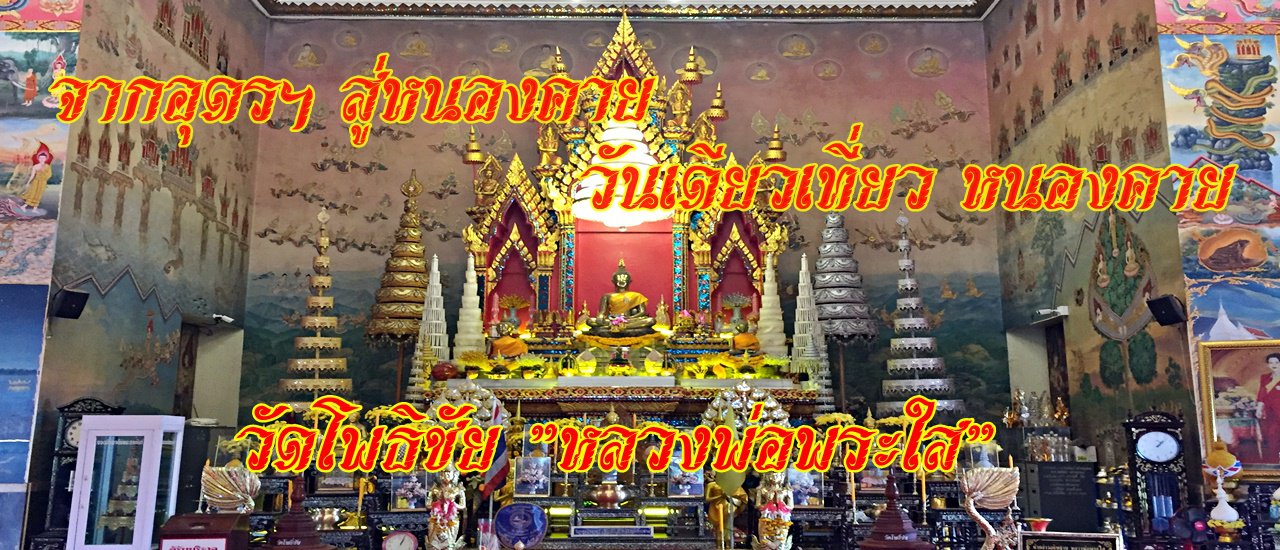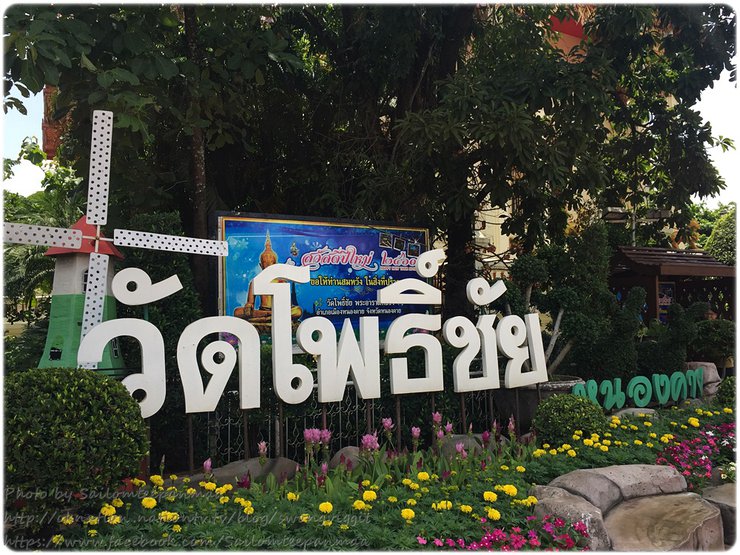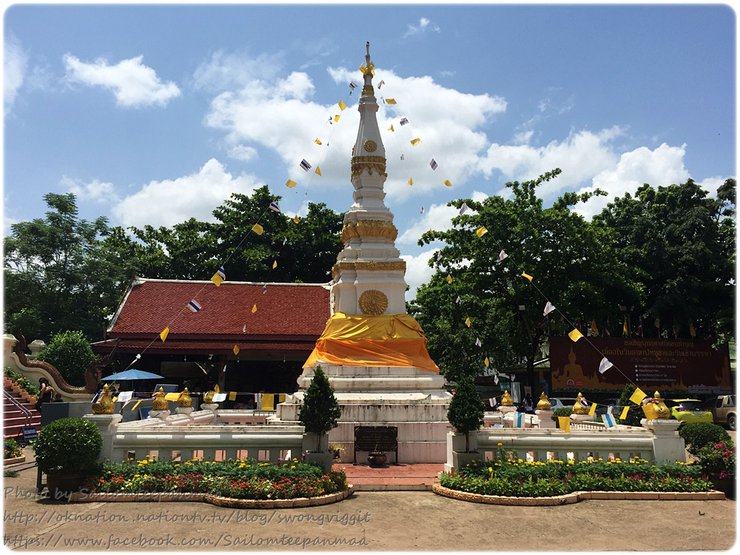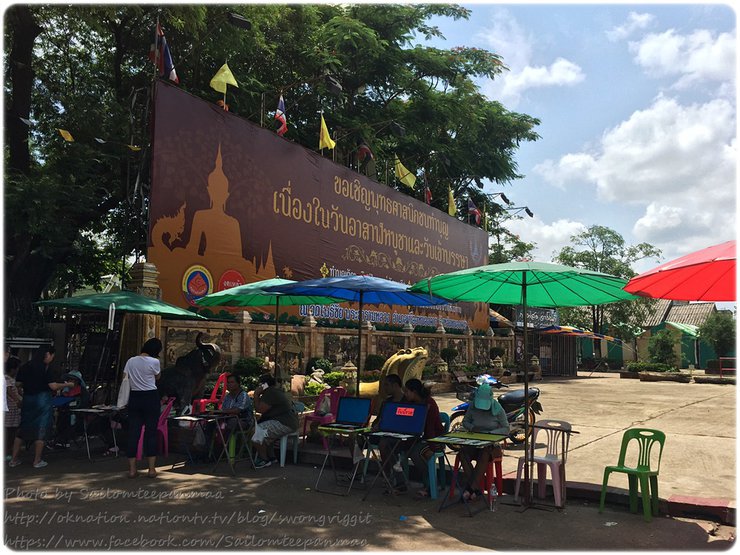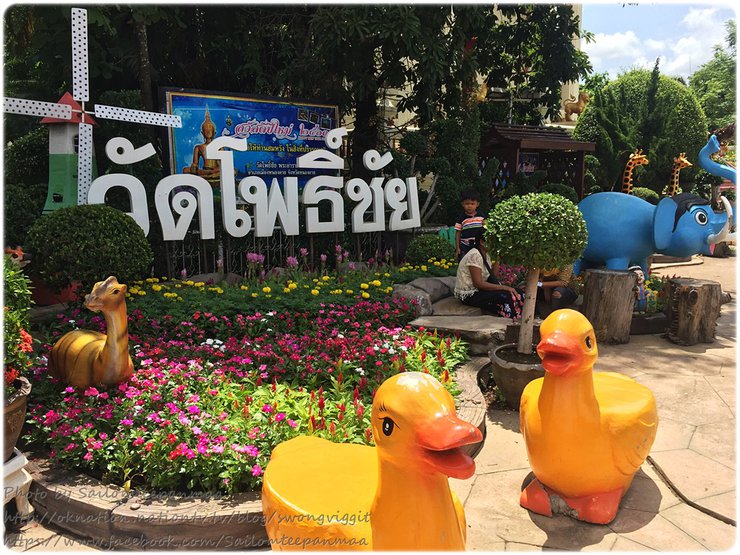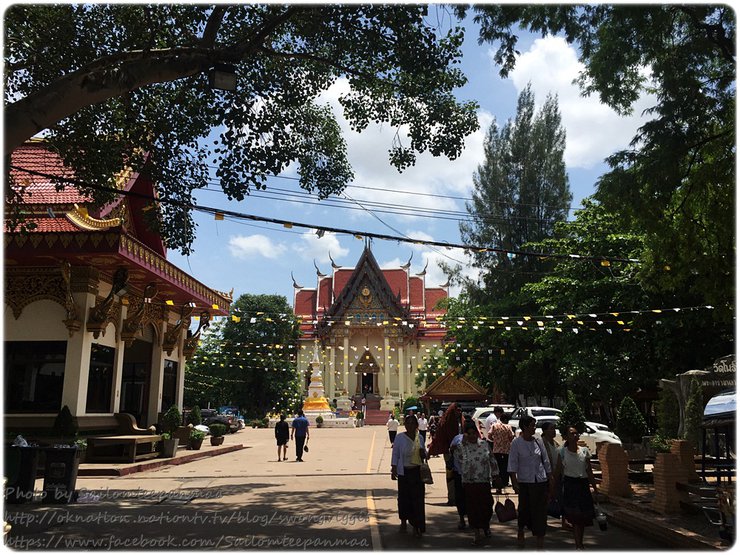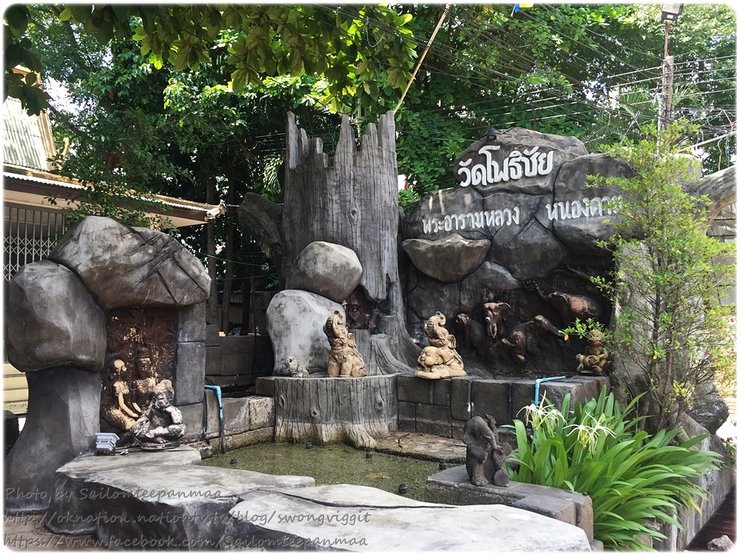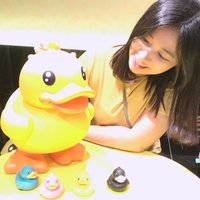
Leaving the Sala Keoku before noon, I decided to pay respects to Luang Pho Phra Sai at Wat Pho Chai before finding something to eat. I wasn't feeling hungry yet. After a short drive, I arrived at Wat Pho Chai.

Yellow Duck at Wat Phothicharoen

The original Wat Pho Chai was an abandoned temple located in Ban Phai, known as Wat Phi Phu. There is no record of its initial construction, but it is believed to have been an important monastery in Vientiane since its inception. When Thao Suva-athamma (Bunma) established Nong Khai city in Ban Phai, he brought important Buddha statues from Vientiane, which had been captured during the suppression of the rebellion of Chao Anouvong, to Wat Hokong in 1829.


The Chapel of Phra Phuttha Sihing
In 1936, an earthquake struck the area around Wat Hokong, causing a large crack to appear in front of the Phra Sai statue. This event sparked various interpretations among the townspeople and officials. Some believed it to be an ill omen, signifying impending hardship for the city. Others interpreted it as a sign that Phra Sai desired to be moved to another temple. Still others argued that Wat Hokong was too small and unsuitable to house a Buddha statue created by the King of Vientiane.


When this happened, Phra Pathumthewa Phiban, the lord of the city and the administration of Nong Khai, consulted with each other on what to do. In the end, they decided to find a place to build a large temple and invite Phra Saen to be enshrined there. The place they chose was Wat Phi Sua.

The Chapel of Phra Phuttha Sihing

The abandoned Wat Phi Phiew, a temple of historical significance, houses a magnificent ancient Laotian stupa. Due to the absence of resident monks, a resolution was passed to restore the temple and rename it Wat Pho Chai. Following the resolution by the Nong Khai City Hall, the city's governor, Phra Pathum Deva Bhipal (Bunma), consulted with Venerable Luang Kham, the most senior monk in Nong Khai.

The three daughters of King Chaiya Chettha of Lan Xang, Princess Suk, Princess Sai, and Princess Sai, commissioned the creation of Luang Pho Phra Sai. While being transported to Bangkok, Princess Suk sank into the Mekong River. The location where Princess Suk sank is still known as "Wen Phra Suk" by locals. Princess Sai is currently housed at Wat Pathum Wanaram in Bangkok.

In 1839, Phra Pathumthewa Phiban (Bunma), the lord of Nong Khai, presided over the laity, while Venerable Yaku Lakham presided over the clergy, to elevate Wat Pho Chai from a temple without resident monks to a temple with resident monks. They also renovated the buildings for the monks and novices on February 21, 1839, as recorded in the Chronicle of Vientiane.


...In the year 201, the governor of Nong Khai (lifted) Wat Pho Sai on the 4th waning day of the 3rd lunar month, Saturday...
After the renovation and elevation of the temple were completed, Phra Pathumthevabhiban (Bunma) invited Phra Yaku Lakkham to be the abbot of Wat Pho Chai. A ceremony was held to invite Phra Saem from Wat Hokong to be enshrined in the sim (ordination hall) of Wat Pho Chai. From then on, Wat Pho Chai became the royal temple of Nong Khai Province because the city lord was the one who built or renovated it. Moreover, 13 days after the ceremony to elevate Wat Pho Chai and invite Phra Saem to be enshrined there, on March 4, 1839, a significant event occurred: a solar eclipse.


Following the year 1839, Phra Saem and Phra Sai were revered by the people of Nong Khai, including officials from Bangkok who regularly visited the city on official business. At that time, Wat Pho Chai had Venerable Yai Ku Lakkham as its abbot, who oversaw the administration and development of the temple as appropriate. With the patronage of the city lord, Phra Pathumthewa Phiban (Bunma), the temple flourished steadily.


When Khun Worathanee and Chao Maen were royal envoys sent to invite Phra Sirim from Wat Pho Chai to Bangkok, Khun Worathanee also intended to invite Phra Sai. However, a miracle occurred. The Brahmin who was invited to carry Phra Sai could not drive the cart, no matter how many people were used or how much they pleaded. Eventually, the cart broke. When a new cart was brought in, it still could not be moved. Therefore, it was decided that Phra Sai would be invited to Wat Pho Chai instead of Phra Sirim. As a result, Luang Pho Phra Sai has been enshrined at Wat Pho Chai to this day.



Wat Pho Chai received the royal grace of His Majesty King Bhumibol Adulyadej, who presided over the raising of the gable finial of the ordination hall in 1979. In 1980, the temple received the royal grant of the boundary of the temple grounds and the ceremony of tying the boundary marker was held in 1981. The temple was elevated to the status of a third-class royal monastery. Currently, Phra Dhammamongkolrangsi (Kham Bo Arunno), advisor to the Sangha Region 8, is the abbot.


The revered Luang Pho Phra Sai is a cross-legged Buddha statue in the Mara-Vijaya posture, cast in gleaming gold. Its exquisite features captivate the beholder. The statue measures 2 cubits and 8 inches in width and 4 cubits and 1 inch in height from the base to the crown of the head. Currently enshrined within the Phra Ubosot of Wat Pho Chai (Royal Monastery), Luang Pho Phra Sai is deeply revered by the people of Nong Khai province as a sacred and highly respected Buddha image.

According to historical records, the three daughters of the Lan Xang king (some believe they were the daughters of King Chaiya Chettha) jointly created three Buddha statues to perpetuate Buddhism. They named the statues after themselves: Phra Suk, Phra Seur, and Phra Sai. The statues were created in descending size, with Phra Suk being the eldest sister's statue, Phra Seur the middle sister's, and Phra Sai the youngest sister's.

According to the temple's history, the construction involved a grand ceremony with both the villagers and monks participating. The furnace was continuously stoked for seven days, but the gold remained unmelted. On the eighth day, at noon, only the abbot and a young novice were left tending the furnace. A white-robed nun appeared and offered to help. The abbot and novice went to have their lunch. The villagers who came to deliver the lunch saw many white-robed nuns helping to stoke the furnace. However, when the abbot asked, he only saw one nun. After lunch, everyone went down to check and was astonished to find all the gold had been poured into the three molds. The white-robed nuns had vanished.


The three Buddha statues, Phra Suk, Phra Sai, and Phra Sim, were enshrined in the capital of the Lan Xang Kingdom for a long time. During times of war and unrest, the statues were hidden on Mount Kwai. When peace returned, they were brought back to their original location. It is unclear when the statues were first enshrined in Vientiane. However, it is known that during the reign of King Rama III, a rebellion led by Chao Anouvong broke out in Vientiane. King Rama III ordered the destruction of Vientiane and sent Prince Maha Sakdi Polsep to suppress the rebellion. After Vientiane was pacified, the three Buddha statues were brought to Nong Khai Province.


According to legend, the three Buddha statues were not directly invited from Vientiane but from Khao Kwai, where the townspeople had hidden them. The statues were placed on a bamboo raft and floated down the Ngum River. When the raft reached Wen Taen, a miracle occurred: the platform of Phra Suk broke away from the raft and sank into the water. This was due to a strong storm that caused the raft to tilt, and the pegs that held the platform to the raft could not withstand the weight of the statue. The area has been called "Wen Taen" ever since.


As they continued their journey down the Mekong River, they reached the mouth of the Ngum River, opposite Ban Nong Kung in Phon Phisai District, Nong Khai Province. A sudden storm broke out, and Phra Suk's raft capsized, causing him to drown. The erratic weather conditions ceased, and the area has been known as "Wen Suk" ever since. As a result of this incident, only Phra Saem and Phra Sai reached Nong Khai. Phra Sai was enshrined at Wat Pho Chai, while Phra Saem was enshrined at Wat Hokong, also known as Wat Pradit Thammakun. A replica of Phra Suk is currently housed at Wat Si Khun Mueang.

During the reign of King Rama IV, Khun Worathanee and Chao Maen (royal officials) were ordered to bring Phra Sirimongkol Buddha statue from Wat Phochai to Bangkok. Khun Worathanee also intended to bring Phra Sai Buddha statue along with Phra Sirimongkol, but a miracle occurred. The Brahmin who was carrying the statue could not drive the cart carrying Phra Sai, no matter how many people were used or how much they pleaded. The cart eventually broke down. When a new cart was brought in, it still could not move. Therefore, it was decided that Phra Sai would be enshrined at Wat Phochai instead of Phra Sirimongkol, which was brought to Bangkok. As soon as this decision was made, Phra Sai could be carried with ease by only a few people.

Prince Damrong Rajanubhab opined that these three Buddha statues are the most exquisite Lanna Buddha statues. He proposed two hypotheses regarding their creation: they may have originated from a city in the east of the Lanna Kingdom and later came to be within Lanna territory, or they may have been crafted within Lanna by Lao Phung Khaeng artisans.

After paying our respects at the temple, we headed to a renowned local restaurant, "Dang Nem Nuong," for a delicious lunch.

สายลม ที่ผ่านมา
Wednesday, February 26, 2025 6:45 PM

